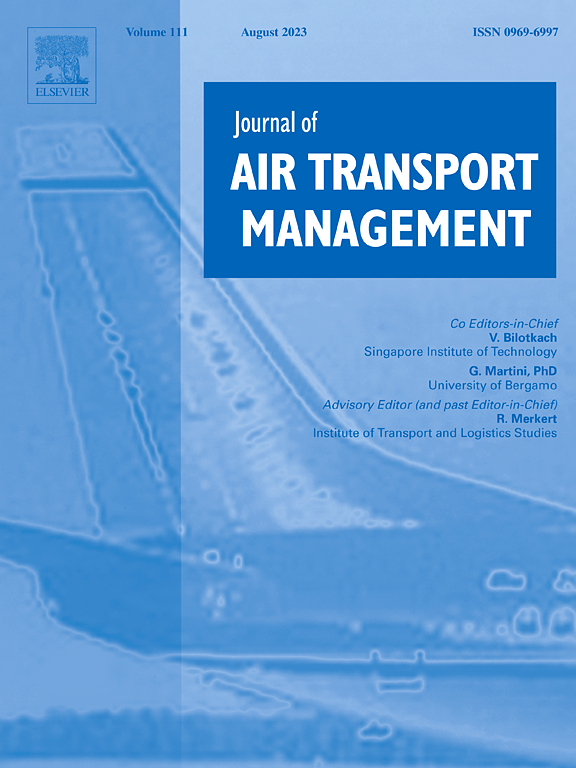Evaluation of the efficiency of world airports using WENSLO-ARTASI and Monte-Carlo simulation
IF 3.9
2区 工程技术
Q2 TRANSPORTATION
引用次数: 0
Abstract
This study addresses the challenge of evaluating and ranking airport efficiency by proposing a novel multi-criteria decision-making (MCDM) framework. The framework integrates the WENSLO (Weights by ENvelope and SLOpe) method for robust weight determination and the ARTASI (Alternative Ranking Technique based on Adaptive Standardized Intervals) method for impartial alternative evaluation. This innovative approach, WENSLO-ARTASI, utilizes a distinctive algorithm for logical reasoning and facilitates effective decision-making in evaluating airport efficiency. The research employs real-world data from the Skytrax website, encompassing airport evaluations across four-star categories (2–5 stars). Nine primary criteria and 49 sub-criteria belonging to 413 airports that remained in the dataset after the cleaning process were identified. The WENSLO technique determined distinct weight sets for each star category, revealing varying priorities among different airport levels. Notably, ground transportation emerged as a critical factor for 2, 3, and 5-star airports, while shopping facilities held greater importance at four-star airports. The proposed WENSLO-ARTASI framework was rigorously evaluated for accuracy and stability through sensitivity and comparative analyses. Parameter fine-tuning within the utility function was performed to assess its impact, followed by comparing the model's results with established MCDM techniques like MABAC, MARCOS, TOPSIS, and WASPAS. The validity of the findings was further corroborated through a Monte Carlo simulation, statistically demonstrating the non-outlier nature of both WENSLO and ARTASI assessments. Additionally, the comparative superiority of alternatives was statistically examined, providing robust evidence for the effectiveness of the proposed framework in airport ranking.
基于WENSLO-ARTASI和蒙特卡罗模拟的世界机场效率评价
本研究通过提出一种新的多标准决策(MCDM)框架来解决机场效率评估和排名的挑战。该框架集成了用于稳健权重确定的WENSLO (Weights by ENvelope and SLOpe)方法和用于公正替代评估的ARTASI (Alternative Ranking Technique based Adaptive标准化区间)方法。这种创新的方法,即WENSLO-ARTASI,利用独特的逻辑推理算法,促进了评估机场效率的有效决策。这项研究采用了Skytrax网站上的真实数据,包括4星级(2-5星)的机场评估。9个主要标准和49个子标准,属于413个机场,在清理过程中被确定。WENSLO技术为每个星级确定了不同的权重集,揭示了不同机场级别的不同优先级。值得注意的是,在2、3、5星级机场,地面交通成为关键因素,而在4星级机场,购物设施更为重要。通过敏感性和比较分析,对提出的WENSLO-ARTASI框架的准确性和稳定性进行了严格评估。在效用函数内进行参数微调以评估其影响,然后将模型结果与已建立的MCDM技术(如MABAC, MARCOS, TOPSIS和WASPAS)进行比较。通过蒙特卡罗模拟进一步证实了研究结果的有效性,统计显示WENSLO和ARTASI评估的非离群性质。此外,对备选方案的比较优势进行了统计检验,为提出的框架在机场排名中的有效性提供了有力的证据。
本文章由计算机程序翻译,如有差异,请以英文原文为准。
求助全文
约1分钟内获得全文
求助全文
来源期刊

Journal of Air Transport Management
TRANSPORTATION-
CiteScore
12.40
自引率
11.70%
发文量
97
期刊介绍:
The Journal of Air Transport Management (JATM) sets out to address, through high quality research articles and authoritative commentary, the major economic, management and policy issues facing the air transport industry today. It offers practitioners and academics an international and dynamic forum for analysis and discussion of these issues, linking research and practice and stimulating interaction between the two. The refereed papers in the journal cover all the major sectors of the industry (airlines, airports, air traffic management) as well as related areas such as tourism management and logistics. Papers are blind reviewed, normally by two referees, chosen for their specialist knowledge. The journal provides independent, original and rigorous analysis in the areas of: • Policy, regulation and law • Strategy • Operations • Marketing • Economics and finance • Sustainability
 求助内容:
求助内容: 应助结果提醒方式:
应助结果提醒方式:


